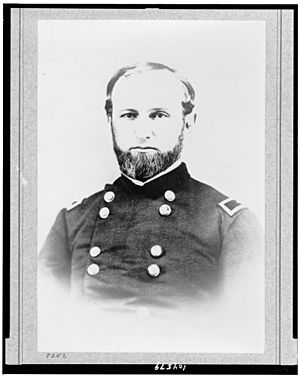Isham N. Haynie facts for kids
Quick facts for kids
Isham Nicholas Haynie
|
|
|---|---|
 |
|
| Born | November 18, 1824 Dover, Tennessee |
| Died | May 22, 1868 (aged 43) Springfield, Illinois |
| Place of burial |
Oak Ridge Cemetery, Springfield, Illinois
|
| Allegiance | United States of America Union |
| Service/ |
United States Army Union Army |
| Years of service | 1847 - 1848, 1861 - 1863 |
| Rank | |
| Commands held | 48th Illinois Volunteer Infantry Regiment |
| Battles/wars | Mexican–American War American Civil War |
| Other work | Lawyer, judge |
Isham Nicholas Haynie was an important person in American history. He was a lawyer, a politician, and a brave soldier. During the American Civil War, he served as an officer in the Union Army. He led the 48th Illinois Volunteer Infantry Regiment as a colonel. His regiment fought in major battles like Fort Donelson and Shiloh.
Contents
Early Life and Career
Isham Nicholas Haynie was born on November 18, 1824, in Dover, Tennessee. This town later became famous for the Battle of Fort Donelson, which Haynie would fight in. When he was young, his family moved to Illinois. There, he worked as a farmer.
Serving in the Mexican-American War
Haynie volunteered to serve in the Mexican–American War. He became a first lieutenant in the Illinois Volunteer Infantry. After the war ended, he left the military in 1848.
Becoming a Lawyer and Politician
After his military service, Haynie went to law school. He graduated from Kentucky Law School in 1852. He then returned to Illinois and started working as a lawyer. He also became involved in politics. He served as a member of the Illinois Legislature. In 1860, he was chosen as a presidential elector. This meant he voted for Stephen A. Douglas in the presidential election.
Civil War Service
When the American Civil War began, Isham Haynie joined the Union Army. On November 10, 1861, he was made a colonel. He was given command of the 48th Illinois Infantry Regiment.
Joining the Army of the Tennessee
Haynie's regiment was part of the District of Cairo. This was a military area led by General Ulysses S. Grant. When Grant planned an attack on Fort Henry, Haynie's regiment joined the expedition. They were part of a brigade led by Colonel William H. L. Wallace. This brigade was in a larger division led by General John A. McClernand. Haynie and his men helped capture Fort Henry.
The Battle of Fort Donelson
Just one week after Fort Henry, Haynie's regiment was involved in the attack on Fort Donelson. On February 13, 1862, Union soldiers were trying to capture the fort. A Confederate cannon battery was causing problems for the Union troops. General McClernand ordered an attack on this battery. He chose Colonel William Ralls Morrison to lead the charge.
Morrison's brigade was small, so McClernand temporarily added Haynie's 48th Illinois to it. As they got ready, Haynie realized he was the highest-ranking officer in the group. Morrison agreed, saying it was no time to argue about who was in charge. Haynie bravely said, "Colonel, let's take it together." Both colonels led their men forward. During the attack, Morrison was shot in the hip. This meant Haynie was fully in command. The attack did not succeed, and the soldiers went back to their lines.
Later, Colonel Leonard Fulton Ross took over Morrison's brigade. Haynie and his regiment returned to Wallace's brigade. Both General McClernand and General Grant wanted to forget about the failed attack. However, years later, McClernand told Haynie's son that he had wanted Haynie to lead the charge because he thought Haynie was a "more able soldier."
The Battle of Shiloh
After the Battle of Fort Donelson, the Union Army was reorganized. Haynie remained in command of his regiment. His brigade was now led by Colonel C. Carroll Marsh, as W.H.L. Wallace had been promoted.
On April 6, 1862, Haynie's regiment fought near Shiloh Church during the Battle of Shiloh. During the intense fighting, Haynie was shot in his left thigh. He was badly wounded and had to give up command of his regiment.
Later Military Service
After recovering from his injury at Shiloh, Haynie continued his service. On November 29, 1862, he was appointed a Brigadier General of U.S. Volunteers. This promotion needed to be confirmed by the U.S. Senate. He was given command of the 1st Brigade, 3rd Division, of the XVII Corps.
However, his commission as Brigadier General expired on March 4, 1863. The Senate had never officially confirmed his promotion. Two days later, on March 6, Haynie resigned from the army.
After the War
After leaving the army, Isham Haynie returned to Illinois. He served as the adjutant general of the Illinois State Militia. This meant he was a high-ranking officer in charge of the state's military forces. Isham Nicholas Haynie died on May 22, 1868, in Springfield, Illinois.

